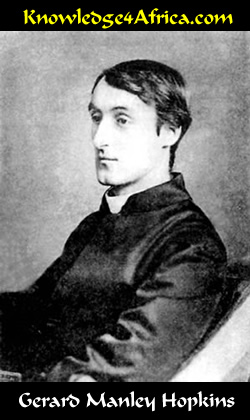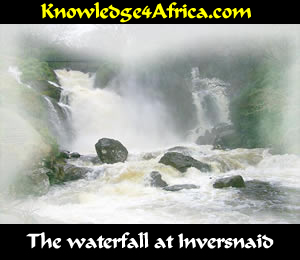|
READ THIS
"Inversnaid" is the description of a stream tumbling down through the highlands of Scotland to the
waterfall at Inversnaid.
At its heart is a hymn of praise for the beauty of creation, as well as an appeal for such wildernesses to
be left unspoilt.
 INSCAPE & INSTRESS
INSCAPE & INSTRESS
At the heart of understanding Hopkins' poetry are two fundamental principles which the poet called
inscape and instress.
Hopkins, in his search for an aesthetic understanding of nature, found value in the writings of the great
medieval theologian-philosopher, Duns Scotus, who attempted to distinguish the difference between the
individual and the species.
What makes Peter different from other men? What makes Angela different from other girls? What
makes my cat different from other cats?
Duns Scotus claimed that Peter and Angela each have an essence, a "this-ness", which is what
marks them apart from others.
My cat too has a "this-ness".
Hopkins would expand on the concept of "this-ness" and call it inscape.
Inscape then is that unique property in things which makes them distinctive. It is the inner essence
of the thing.
This uniqueness represents the beauty of the thing. Even more: it represents the beauty of God that is
reflected in the thing.
When the poet looks into the sky in the morning and sees a falcon floating on the wind, he sees more than
just a bird. He sees the inner beauty of the bird.
But within this inner beauty, he also sees the beauty that is God. The falcon's inscape is therefore
the beautifying principle of God himself.
Not everybody, however, can see this inscape, this inner manifestation of beauty and the presence
of God. Only the true artist can see it.
And Hopkins gave the name instress to this ability to witness the inscape in something.
Instress is therefore the feeling that one has for the inner quality in something. This is what
characterises the artist.
Instress is the mystical ability that enables the artist to perceive the inner beautifying
principle or inscape.
Instress is the sensation of inscape, where the artist becomes aware of the
inscape of the thing of beauty.
Most living people, Hopkins said, are fundamentally dead to this world of inscape, i.e. most people
just cannot see this inner beauty in something else.
Artistic creation, on the other hand, happens when the artist becomes instressed with the personal
inscape of the other.
The work of art that then follows -- e.g. a poem or painting -- is what Hopkins called a new
inscape.
The poem or painting thereupon has its own inscape -- i.e. it too becomes a thing of beauty which
reflects the beauty of God.
When the reader's inscape becomes aware of the beauty of the poem, then the reader has become
instressed.
But once again, not everybody has this ability. The kid in the classroom who bleats, "Ma'am, why do
we have to do poetry?" says this because he lacks instress.
He's the type of being who looks at the sunset and is reminded of a fried egg, soft side up.
Have you looked at the questions
in the right column?
|
TEST YOURSELF!
Read the left column and then answer
the following questions:
Hopkins is noted for the lyrical or musical quality of his poetry.
- Explain how he uses various language devices to achieve this lyrical effect. (10)

[Need help?]
It would seem that Hopkins learnt the lyrical way of speaking through his years of priestly training in
Wales.
He achieves it sometimes by the juxtaposition of words which lend to the rhythm of the piece --
"This darksome burn, horseback brown" and "It rounds and rounds Despair to drowning".
Sometimes the poet achieves the lyrical effect through alliteration -- "In coop and in comb the
fleece of his foam" and "Degged with dew, dappled with dew".
He also uses onomatopoeia to create the lyrical effect -- "His rollrock highroad roaring
down" and "flitches of fern".
A fourth device is the use of assonance, or rhyming within the line -- "In coop and in
comb" and "It rounds and rounds Despair to drowning".
Can you find any other examples of any of these devices?
|
This poem is noted for Hopkins' creation of words. How do the following words add to the descriptive or
lyrical quality of the piece?

[Need help?]
As with all created words, one has to work out both what the poet means and what effect the words have
in creating the effect which the poet desires.
One has to see "rollrock" within the context of the line in which it appears: "His rollrock highroad
roaring down".
We note first the use of alliteration. But consider what letter is being alliterated -- the "r"
-- and also the way in which the Scots would pronounce this letter. Indeed, they would roll the letter
around their tongues.
The result of the alliteration then would be to recreate the sound of the water roaring over the falls. So
the alliteration is used both for its lyrical quality as well as for its onomatopoeic effect.
|
- "windpuff-bonnet of fáwn-fróth". (4)

[Need help?]
"Windpuff-bonnet of fáwn-fróth": the little puffs of froth float away on the air, like seeds
of such plants as the dandelion and the thistle.
It probably reminds the poet of tiny bonnets being puffed around by the wind.
Since the colour of the water is "horseback brown", it is natural that the froth would be fawn in
colour: "fáwn-fróth".
By the way, have a look at the colour of the water in the picture opposite. Pass your mouse-cursor over
the picture to pop up an enlarged one.
|

[Need help?]
"The beadbonny ash": At first glance, the poet is probably referring to little red beads or berries
on the tree.
The alliteration, however, creates a lyrical effect.
But is not the poet being reminded by the beads or berries of his rosary beads -- he being a Catholic
priest who would have had a very strong devotion to praying the rosary?
|
Of a pool so pitchblack, féll-frówning,
It rounds and rounds Despair to drowning.
- Some commentators, knowing of Hopkins' repeated states of depression in his later life, conclude that
the poet is succumbing to such depression in this verse. Is this a correct
interpretation? (10)

[Need help?]
Hopkins is famed for his nature poems which brim over with praise of God. It would seem that Hopkins
is overflowing with such praise here, as he becomes entranced by the Inversnaid Falls.
It does not, therefore, seem to be the place to bring in his later moods of depression but the problem lies
in two sets of words which may denote depression: "féll-frówning" and "Despair to
drowning".
But do these words suggest despair and depression?
The first -- "féll-frówning" -- describes the blackness of the loch or lake. It might also
refer to the hills overhanging the loch which frown, casting a shadow over the loch and making the water
appear even darker than usual.
The second -- "Despair to drowning" -- is most probably an inverted word order. The poet does
not mean that this beauty makes him want to drown himself in despair but rather that so much beauty will
drown even Despair itself.
In other words, who could be in a state of despair when confronted by so much beauty?
|
Is there a change of mood between the first three verses and the final verse? (4)

[Need help?]
It does seem that the first three verses are total praise for the beauty of the Inversnaid Falls. The fourth
verse, on the other hand, is a plea not to allow urbanisation or growing industrialisation to destroy this
beauty.
One could also argue, however, that the final stanza is the closing of his argument. With beauty like this,
there is no place for urbanisation and the things that go with it.
Indeed, it is only the existence of such beauty that makes the rest of the urbanised world at all bearable.
|
Hopkins coined the words "Inscape" and "Instress" to describe the poet's craft.
- To what extent would it be correct to use these words in association with the Inversnaid
Falls? (10)

[Need help?]
Inscape and Instress is what explains the artistic world.
Everything has a certain nature. A tree is a tree, a stream is a stream. Everything in nature also contains
the essence of God. Hopkins called this quality Inscape.
The ability for appreciating Inscape is called Instress. Some people, however, just cannot
experience the magic of a forest in the mist of dawn, or the alchemy of the tumbling stream.
When a poet writes, he attempts to portray the Instress in himself so as to inflame it in the reader. The
school child, however, who asks, "Why do we have to study this stupid poetry?" lacks this Instress
and no amount of teaching will impart it.
The poet uses poetic devices to portray the Inscape of the Inversnaid Falls and the God-principle within
that makes them alive to the poet.
He is attempting to transfer his own Instress to the reader but only those who possess a marked degree
of Instress will appreciate it.
To the others, it is just another stupid poem.
|
|





